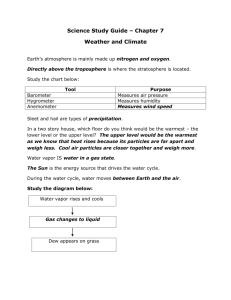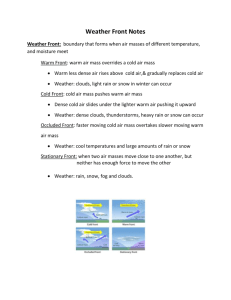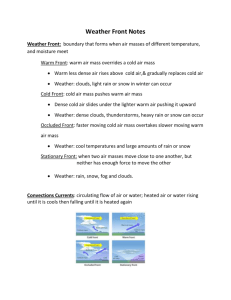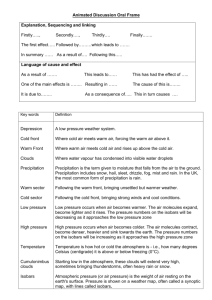Earth*s Weather
advertisement
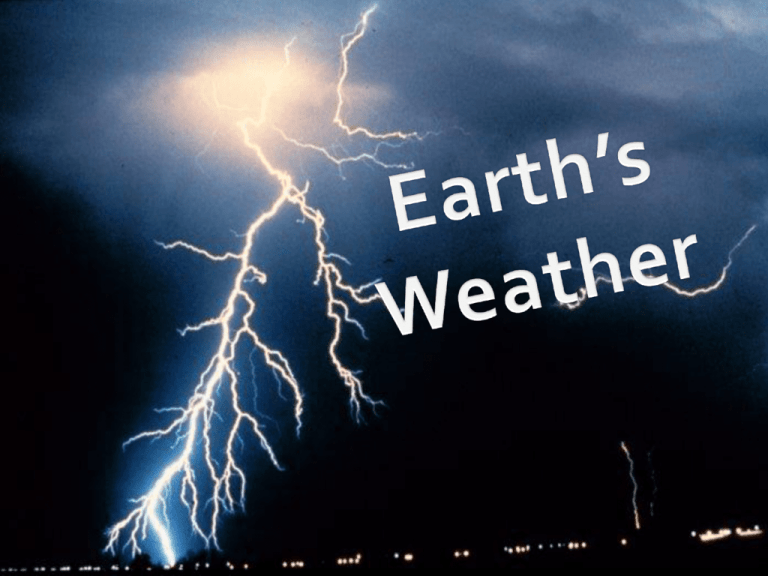
EARTH’S WEATHER The atmospheric factors that cause weather are heat energy, air pressure, winds, and moisture in the air. Air pressure depends on the density of the air. Factors affecting air pressure are temperature, water vapor in the air, and elevation. Barometers measures air pressure and are very important in predicting the weather. There are two types of barometers; mercury and aneroid. Mercury barometers were invented in 1643 and contain mercury in a glass tube. As air pressure decreases, mercury level drops. As air pressure increases, mercury level increases. High pressure usually means fair weather. Low pressure leads to cloudy, rainy or snowy weather but there are exceptions. Aneroid barometers (used in homes) are an airtight metal box which most air has been removed. When there is a change in pressure it causes the needle to move along a dial. Local and global winds are caused by differences in air pressure due to unequal heating of the air. In the United States jet stream winds blow from west to east. Water vapor, or moisture, in the air is called humidity. There are three main types of clouds, Cumulus, Stratus, and Cirrus. Cumulus clouds look like piles of cotton balls. They are fluffy and white with flat bottoms. Cumulus clouds usually mean fair weather. However, When cumulus clouds get larger and darker on the bottom (cumulonimbus), they produce thunderstorms. Stratus clouds are smooth, gray clouds that cover the whole sky and block out the sun. Light rain and drizzle are usually associated with stratus clouds. Cirrus clouds are feathery and form at very high altitudes, You can see cirrus clouds in fair weather, but they often indicate that rain or snow will fall within several hours. Water vapor that condenses and forms clouds can fall to the Earth as precipitation in the form of rain, sleet, snow, or hail. The four major air masses that affect weather in the United States are maritime tropical, maritime polar, continental tropical, and continental polar. When two air masses meet, a cold front, a warm front, and occluded front, or a stationary front may form. A storm is a violent disturbance in the atmosphere. It is marked by sudden changes in air pressure and rapid air movements. Storms may cover a huge area and others cover only a small area. Rainstorms and snowstorms -- when two different fronts collide, rainstorms or snowstorms form. Thunderstorms --when a cold front moves in and meets a warm front, cumulonimbus clouds produce thunderstorms. What makes thunderstorms so dangerous is the lighting. Lighting is the sudden discharge, or spark, of electricity between two clouds or between a cloud and the ground. Hurricanes -- a low-pressure area containing rising warm air that forms over tropical oceans. Tornadoes -- a whirling, funnel-shaped cloud that develops in low, heavy cumulonimbus clouds Meteorologists use data from local weather observers. Balloons, satellites, and weather stations to predict the weather. Greenhouse effect - process in which carbon dioxide and other gasses in the atmosphere absorb infrared radiation from the sun, forming a "heat blanket" around the Earth. Instruments used in measuring and predicting weather. Anemometer - instrument used to measure wind speed. Barometer - instrument used to measure air pressure. Wind Vane - instrument used to measure wind direction. Rain Gauge - instrument used to measure the amount of rainfall. Thermometer - instrument used to measure air temperature. Cloud formation and Precipitation Clouds form when water vapors, or moisture, in the air condenses on small particles of dust in the air. When a cloud gets heavy enough, precipitation will fall back to the Earth. Types of precipitation include: Rain - drops of liquid water. Sleet - water droplets that freeze into small ice pellets. Snow - water vapor that changes directly into solid flat six-sided ice crystals. Hail - most damaging form of precipitation. Usually formed in Cumulonimbus clouds. Hail is small balls or chunks of ice ranging from 5 to 75 mm in diameter. They form when water droplets hit ice pellets in a cloud and freeze. Fronts Cold Front - A cold front forms when a cold air mass meets and pushes under a warm air mass. Violent storms are associated with a cold front. Fair, cool weather usually follows. Warm Front - A warm front forms when a mass of warm air overtakes a cold air mass and moves over it. Rain and showers usually accompany a warm front. Hot, humid weather usually follows. Fronts Occluded Front - An occluded front occurs when a cold front travels faster than a warm front. When a cold front overtakes a warm front, an occluded front forms. An occluded front produces less extreme weather than a cold front or a warm front. Stationary Front - A stationary front occurs when a warm air mass meets a cold air mass and no movement occurs. Rain may fall in an area for many days when a stationary front is in place. Measuring Temperature Temperature is measured in units called degrees. The temperature scale used by scientists is the Celsius scale. On the Celsius scale, the freezing point of water is 0o C. The boiling point of water is 100o C. Normal body temperature is 37oC.

